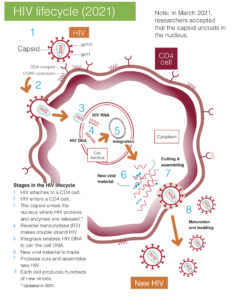The HIV lifecycle
HIV is a tricky virus. Instead of being destroyed by the immune system it uses immune cells to reproduce.
For the first 10 days or so, HIV stays hidden. It is impossible to detect or test for. But millions of copies of the virus are already being made in lymph nodes near the body site of infection.
When these swollen lymph nodes burst, HIV is carried throughout the body. In response, your immune system makes even more immune cells, especially CD4 cells.
This process lasts a several weeks until your immune system starts to reduce levels of HIV. The period is called seroconversion.
Instead of clearing the virus, CD4 cells are used by HIV to replicate. This continues until you start ART.
The replication cycle
Each replication cycle lasts for about two days and has several stages. Each stage can be a target for HIV drugs.
- First, HIV attaches to the surface of the cell.
- Then it is absorbed through the cell wall, losing its outer coating or shell.
- The inner capsule – the capsid – releases proteins and enzymes into the nucleus. HIV uses these enzymes (RT, integrase and protease) to replicate.
- RT converts the single strand of HIV in the nucleus to match double-strand human DNA.
- This double strand of HIV then joins (or integrates) into human DNA.
- The nucleus now produces the raw material to make new HIV.
- These particles need to be cut up and reassembled by protease before new virus can fully function.
- This process continues after new virus leaves the cell. Each CD4 cell produces hundreds of new copies of HIV particles – called virions. These virions bud from the cell while HIV continues to develop. The CD4 cell then dies.
- New HIV then infects other CD4 cells and this process is repeated millions of times each day.
- Although HIV only infects one in a thousand CD4 cells, these cells signal to uninfected CD4 cells to also die early.
- Without ART, the immune system becomes worn down. The immune system puts up a good fight – often for many years – but steadily and eventually loses.
- But with ART, the HIV lifecyle is stopped and the immune system can repair itself.
This page updates earlier editions to describe the capsid being absorbed directly into the nucleus and to update the diagram.
See CROI 2021: HIV capsid uncoats in the CD4 nucleus rather than the cytoplasm – viral lifecycle updated…
i-base.info/htb/40151
The animation of capsid uncoating is about 24 minutes into this online webcast:
croiwebcasts.org/console/player/47960
Last updated: 1 January 2025.

